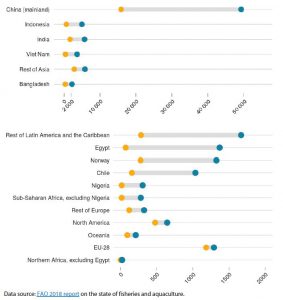Around 70 % of the seafood consumed in the EU is imported. In order to cope with growing demand for seafood, future increases in EU fish product supply will have to be driven primarily by aquaculture. According to 2016 figures, about 75 000 people are directly employed in aquaculture in the EU. Out of the three sub-sectors (marine, shellfish and freshwater), marine aquaculture has the lowest employment but accounts for 51 % of EU aquaculture production in terms of value. The most important marine fish species in aquaculture in the EU-28 is salmon (the vast majority of which is farmed in the UK) and sea bream and sea bass (with Greece as the main producer). Production in the EU-28 has remained more or less stable over the past 20 years, whereas world production has more than tripled. In Norway, production rose from 278 to 1 326 thousand tonnes in the period from 1995 to 2016 (see Figure 3 below). In line with the 2013 CFP reform and the strategic guidelines on aquaculture, multiannual national plans have been developed by Members States to increase competitiveness, reduce administrative burdens and take advantage of the high quality of EU aquaculture products resulting from strict environmental, animal health and consumer protection standards.
Increase in aquaculture food fish production from 1995 to 2016, by selected major producers in Asia and the rest of the world (in thousand tonnes)
Visit the European Parliament page on
Visit the European Parliament page on
We write about
RSS Link to Scientific Foresight (STOA)
RSS Link to Members’ Research Service
Blogroll
Disclaimer and Copyright statement
The content of all documents (and articles) contained in this blog is the sole responsibility of the author and any opinions expressed therein do not necessarily represent the official position of the European Parliament. It is addressed to the Members and staff of the EP for their parliamentary work. Reproduction and translation for non-commercial purposes are authorised, provided the source is acknowledged and the European Parliament is given prior notice and sent a copy.
For a comprehensive description of our cookie and data protection policies, please visit Terms and Conditions page.
Copyright © European Union, 2014-2019. All rights reserved.








Be the first to write a comment.